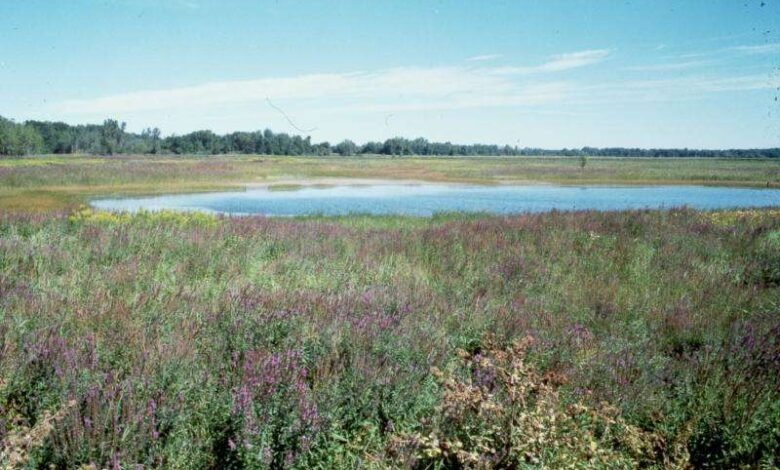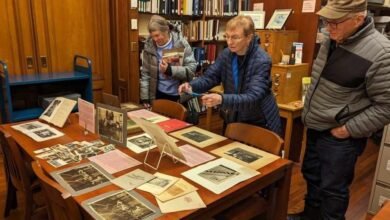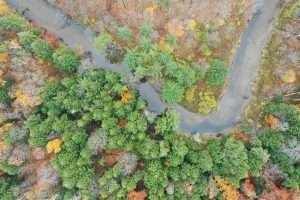Drilling For Salt: Salt Springs & New York’s Salt Industry Origins


 As the presence of salt in New York was first made manifest through saline mineral springs it is proper to begin this discussion with the history of their discovery and utilization. The most important of these are in Onondaga County at Syracuse.
As the presence of salt in New York was first made manifest through saline mineral springs it is proper to begin this discussion with the history of their discovery and utilization. The most important of these are in Onondaga County at Syracuse.
About the middle of the seventeenth century several of the Jesuit missionaries during their journeys among the Haudenosaunee (Iroquois), in what is now the State of New York, heard local salt springs and related these experiences in the Relations of the Jesuit fathers.
Father Jerome Lallemant [1593-1673] says in his relation, 1646: “The fountain from which very good salt is made, springs up in a beautiful plain surrounded by a fine wood. At eighty or a hundred paces from this salt spring is another one of fresh water, and these two take their birth from the bosom of the same hill.”
In 1646 Pierre François Xavier de Charlevoix [1682-1761] said: “The Canton of Onondaga has a very beautiful lake called Ganentaha [Onondaga Lake, which the French called Salt Lake] around which are several salt springs and of which the borders are always covered with very fine salt.”
In 1655, François du Creux (Franciscus Creuxius) [1596?-1666] speaking of the shores of Lake Ganentaha: “The meadow is intersected by two fountains situated about a hundred paces from one another; of the one the salt water furnishes an abundance of the best salt; the pure water of the other is good to drink, and what is remarkable is that both spring from one and the same hill.”
Father Simon Le Moyne [1604-1665] says in his relation of the return voyage from the Iroquois nations in August, 1664: “We arrived at the inlet of a small lake, in a great basin half dry. We tasted the water of a spring which they dared not drink, saying that there was in it a demon which rendered it fetid, and having tasted it I found that it was a fountain of salt water; and in fact we made from it salt as natural as that from the sea, of which we carried a specimen to Quebec.”
This discovery of salt by the Jesuits led to its wider manufacture by the Iroquois and traders. This salt was in common use among Iroquois and the Delaware (Lenape) and traders were in the habit of bringing it to Albany along with their furs.
Early Development of the Onondaga Salt Field
The systematic manufacture of salt in the vicinity of Syracuse by settlers was begun in 1788. In a letter from Colonel Comfort Tyler [1764-1827] to Dr. Jeremiah Van Rensselaer [1738-1810] he says that in May, 1788, his family needed some salt and he obtained about a pound from the Onondaga which they had made from the springs near the shore of the lake.
They offered to show him the location of the brine springs and accordingly he went to the lake with a guide. The guide in his canoe took Col. Comfort out of the mouth of Onondaga Creek easterly into a pass since called Mud Creek.
After passing over the marsh then covered by about three feet of water and starting toward the bluff upon which was afterward founded the village of Salina, he fastened his canoe and pointed-out the hole in the ground which had apparently been dug there to improve the salty spring.
In the same year Asa Danforth [1746-1818] and Col. Tyler undertook the manufacture of salt in a very primitive way, their only outfit being a five-pail kettle suspended by a chain from a pole resting upon two crotched stakes.

 In 1789 Nathaniel Loomis [1746-1824] started a small establishment with a number of kettles and during the winter of 1789-90 made from 500 to 600 bushels of salt which he sold for $1 a bushel. William Van Vleck made salt at Salt Point [Syracuse] and Jeremiah Gould afterwards made salt in kettles on arches.
In 1789 Nathaniel Loomis [1746-1824] started a small establishment with a number of kettles and during the winter of 1789-90 made from 500 to 600 bushels of salt which he sold for $1 a bushel. William Van Vleck made salt at Salt Point [Syracuse] and Jeremiah Gould afterwards made salt in kettles on arches.
In 1793 Moses Dewitt and William Van Vleck entered into partnership, erected an arch containing four potash kettles and manufactured salt enough for the wants of the inhabitants of the neighboring country.
In the same year James Geddes [1763’1838] began manufacturing salt at the place which now bears his name [the town of Geddes], and shortly after John Danforth begun to make salt at Liverpool, NY.
In 1797 the legislature of the State of New York passed the first laws relating to the manufacture of salt, including its taxation, at the Onondaga salt springs and William Stephens was appointed superintendent of the Onondaga Salt Reservation, which the state set aside for the production of salt [see map, details of this act may be found in the laws of that year].
In 1798 an association of operators around Onondaga Lake called the Federal Company was organized. It erected the largest plant known at that period, consisting of 32 kettles which were set in blocks of four each. The brine was pumped by hand from shallow wells, less than 30 feet deep, into reservoirs made of hollow logs.
The first well of any large size was sunk under the direction of William Kirkpatrick [1769-1832] who was appointed superintendent in 1806. This well was at Salina. It was 20 feet square and 30 feet deep. Each manufacturer had his own pump which was worked by hand and the brine was carried in conduits to the different works.
In 1810 under Superintendent John Richardson, the water of Yellow Brook was conducted from Syracuse to Salina in order to drive a wheel for pumping the brine. Shortly afterward the pumps were worked by horse-power.
In 1820 the legislature authorized Benajah Byington to bore for rock-salt on the Onondaga Salt Springs Reservation offering a premium for any salt produced. His explorations were chiefly made on the high grounds east of Salina and were entirely unsuccessful.
In 1838 an appropriation was made to enable the superintendent to sink a shaft or well 600 feet deep. A well was sunk to this depth but without finding any rock salt.
Other Salt Brine Producing Areas
The brine springs of Montezuma in Cayuga County were only second in importance to those of Onondaga County and for a time were utilized in the manufacture of salt. In 1823 the salt made there amounted to between 16,000 and 20,000 bushels.
The following additional list of brine springs is taken from the report of Lewis C. Beck on the mineralogy of New York 1842. As the matter has not since been investigated [in 1892] no later record is accessible.


Up to the date of that report [1842] no salt springs had been found east of Saltspringville, about 14 miles from Cooperstown near the line between Otsego and Fulton Counties.
(Salt Springville, also known as Salt Springsville, is a hamlet southeast of Fort Plain and Canandaigua, in the towns of Minden and Cherry Valley, on the Montgomery County and Otsego County border).
These springs were very weak in brine containing only 3% or 4%, but were of sufficient importance to furnish salt to the people residing in that region.
In 1833 a brine spring was discovered in Delaware County on Elk Brook, about four miles from Delhi. In Oneida County salt springs occur near Vernon Center and again near Oneida. According to Amos Eaton [1776-1842] these are the first brine springs in the Salina group.
Brine has also been found at Lenox in Madison County. At the town of Triangle in Broome County salt water occurs which yields salt of great purity, and brine is also said to exist in the County of Cortland.
In Oswego County are several weak brine springs. One of these is in a marsh two miles square in the town of Hastings. Two miles west of this is another spring. At Central Square is still another. There are other salines in the towns of Constantia, Richland and Hannibal. From the eastern part of Oswego County to the Niagara River numerous brines are found in the red sandstone.

 In Wayne County are several salines. They are near Galen in the town of Savannah on the western edge of the Cayuga marshes [Montezuma Marshes]. This brine contains somewhat less than 9% of salt. There is also a spring about two miles from Lockville (now Newark, NY). Another brine spring is near the head of Little Sodus Bay. Weak brine has been reported from the village of Clyde.
In Wayne County are several salines. They are near Galen in the town of Savannah on the western edge of the Cayuga marshes [Montezuma Marshes]. This brine contains somewhat less than 9% of salt. There is also a spring about two miles from Lockville (now Newark, NY). Another brine spring is near the head of Little Sodus Bay. Weak brine has been reported from the village of Clyde.
A few salines, not of economic importance, are found in Monroe County. One of these is on Irondequoit Bay two or three miles from Lake Ontario. Salt was at one time manufactured from this brine. Another spring, also some what worked formerly, is in the town of Greece two miles north of the ridge road and nine miles west of the City of Rochester.
To these may be added the three springs on the banks of the Salmon Creek near Clarkston two miles north of Ladd’s Corners [in Cayuga County]. Salt springs are moreover of frequent occurrence along almost all creeks and small streams, and salt was formerly manufactured from some of them in small quantities.
In 1834 brine was found in Livingston County 2 1/2 miles southwest of York. This supply after a time, ceased to flow. Salt water was found by boring, in the town of Elba (in Genesee County), eight miles northwest of Batavia.
A number of brine springs have been observed in Orleans County. In Carlton, at Kendall and at Holley (in the town of Murray), salt has been manufactured from saline springs. At Oak Orchard also, salt has been made from the natural brine.
In Niagara County several brine springs occur on Eighteen Mile Creek between Lockport and Lake Ontario.
Read more about the Salt Industry in New York State.
This essay is extracted from Assistant State Geologist Frederick J.H. Merrill’s “Salt and gypsum industries of New York,” in Bulletin of the New York State Museum, Vol. 3, No. 11, April 1893. It has been edited to update language and annotated by John Warren.
Note on additional sources: The history of the discovery and development of the salt beds of Western New York was discussed at length by Irving P. Bishop in the Report of the State Geologist for 1884. The growth and development of this industry is best shown by a complete list of producers in 1892-93. Another good source is W. C. Phalen, Salt Resources of the United States, United States Geological Survey Bulletin 668, 1919. Merrill’s “Salt and gypsum industries of New York” contains numerous photos of 19th century salt industry.
Illustrations, from above: Carncross Salt Pond, a rare inland salt marsh, protected by The Nature Conservancy, located in Wayne County, NY (NY Natural Heritage Program); a diorama of early brine salt manufacturing at the Salt Museum in Onondaga County; a 1932 Historic Marker, “1739 Ancient Salt Springs” in Salt Springsville, Montgomery County; and a late 18th-early 19th century Spring Pole Well Drilling Rig diagram.
Source link




